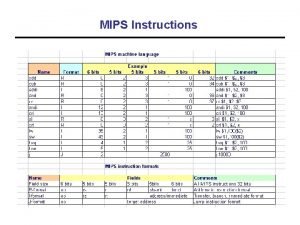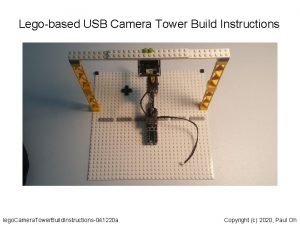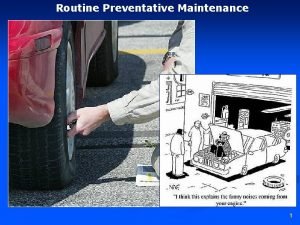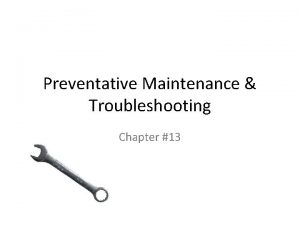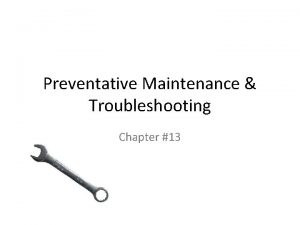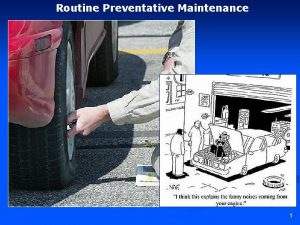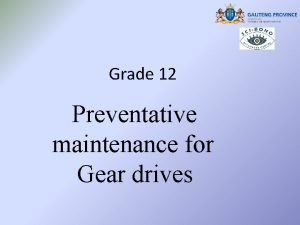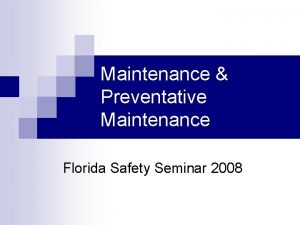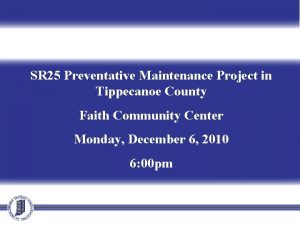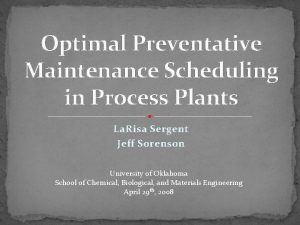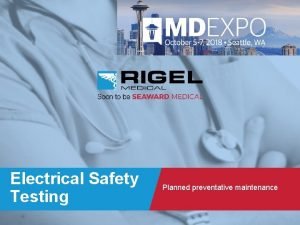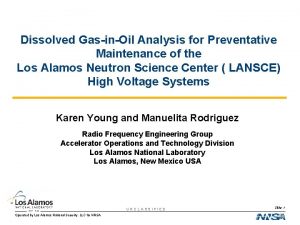Nieco JF 93 G Gas Preventative Maintenance Instructions


















- Slides: 18

Nieco JF 93 G Gas Preventative Maintenance Instructions May 16, 2017

Procedures Preventative Maintenance should be performed every 12 months PM should be scheduled either after closing or prior to opening 1. 2. 3. 4. 5. 6. 7. 8. 9. Inspect power supply cord and cap. Check cap for signs of overheating. Check cord for cracks and breaks. Inspect gas hose and connections for cracks and leaks. Inspect all four wheels/casters. Replace any that are bent or not turning properly. Tighten any that are loose. Remove all the daily, weekly and monthly parts from the broiler and inspect. Make note of any broken or abused parts. Straighten any bent sheet metal parts. Remove and clean both upper air boxes. Remove and clean lower burner. If equipped, Inspect the Incendalyst for damage and cleaning. Clean with water only. Fill out PM inspection form. Required Maintenance Lubricate drive and feeder chains Replace both feeder clutch plastic bushings Replace hot surface igniter Replace flame sensor and wire Remove and inspect (clean if needed) upper air boxes/burner Replace all main burner orifices Replace all pilot orifices, including zip tube orifice Adjust all gas pressures Calibrate broiler

Inspection Sheet Restaurant Number ______ Date: ___________ Serial Number ________ Inspected and good condition Needs follow up service Needs Immediate service or replacement 1 Inspect Power cord and plug 2 Inspect Casters 3 Inspect Panels and all other removable parts 4 Inspect Gas hose and supply. Check hose for gas leaks with bubbles 5 Inspect restraining cable and fastenings 6 Inspect broiler frame (cross rods & supports) 7 Remove and Inspect lower burner 9 Inspect Incendalyst (Catalyst) 10 Remove and inspect upper air boxes 11 Inspect all wiring connections in control box 12 Inspect control box for grease or water (clean if needed) 13 Inspect and adjust both feeders Service or replacement completed COMPONENT CHECK

Disassembly

Disassembly

Disassembly

Lubricate all Drive Chains Feeder Chain Feeder Bearing Drive Chain 1. 2. 3. 4. 5. Remove side covers. Lubricate Drive Chains. (Main and Flex sides)(We suggest using high temperature grease) Lubricate Feeder Chains. (Main and Flex sides) (We suggest using high temperature grease) Remove feeder drive and replace plastic bushing. (Main and Flex Sides) Install feeder assembly and align pin with feeder.

Replace Ignition Parts Hot Surface Igniter Flame Sensor 1. Replace the Hot Surface Igniter 2. Replace the Flame Sensor

Orifice Replacement # 1 2 3 4 5 JF 93 G NG BK DRAWING 25103 Description Part # Orifice, lower burner, #44 2022 Orifice, upper burner #52 18152 Orifice, lower pilot (5232) 2047 Orifice, upper pilot (3225) 2182 Orifice, zip tube #70 22930 Qty 2 1 1 # 1 2 3 4 5 JF 93 G LPG BK DRAWING 25102 Description Part # Orifice, lower burner, #54 2065 Orifice, upper burner #60 18160 Orifice, lower pilot (4214) 17276 Orifice, upper pilot (4212)) 2023 Orifice, zip tube #78 23481 Qty 2 1 1

Orifice Replacement BKEMEA ONLY # 1 2 3 4 5 JF 93 G NG BKEMEA DRAWING 26408 Description Part # Orifice, lower burner, #46 2051 Orifice, upper burner #50 18150 Orifice, lower pilot (5232) 2047 Orifice, upper pilot (3225) 2182 Orifice, zip tube #70 22930 Qty 2 1 1 # 1 2 3 4 5 JF 93 G LPG BK DRAWING 25102 Description Part # Orifice, lower burner, #54 2065 Orifice, upper burner #60 18160 Orifice, lower pilot (4214) 17276 Orifice, upper pilot (4212)) 2023 Orifice, zip tube #78 23481 Qty 2 1 1

Upper Air Boxes/Burner • Disconnect air tubes from supply fitting • Remove air boxes/burner • Take air boxes/burner assembly to the sink and clean all air and gas holes • Allow to dry Air Holes Gas Holes

Temperature Control Actual Temperature Set Point Not Used Adjust Temperature Up Not Used Adjust Temperature Down

Temperature Control XXX Set Point _______XXX Actual Temperature __ Not Used % Valve is Open Adjust Temperature Up Adjust Temperature Down

Gas Components Manifold Test Port P/N 18096 Main gas Regulator P/N 2049 -A Pressure Test Port P/N 18096 Modulating Gas Valve P/N 21316

Modulating Gas Valve Max Setting / Adjustment Up Button Dip Switch Setting Switch # 1 & 2 = On Switch # 3 = Off Min Setting / Adjustment Down Button Red Indicator Light Solid light is for Max Setting Blinking light is for Min Setting

Adjust Gas Pressure Natural Gas 1. Install your manometer on the test port just past the main gas regulator. Adjust pressure to 5. 5” wci. 2. Install your manometer at the pressure tap on the burner manifold. 3. Remove the blue cover on the Modulating Gas Valve. 4. There are two white buttons on this control, one on the inside and one on the outside that adjust the maximum and minimum gas pressure respectively. 5. Turn on the broiler and set the temperature control to 1000 degrees 6. Push and hold the inner button (max) until a solid light on the circuit board comes on. Now use your two buttons to adjust the max (High) gas pressure to 4” wci. The inner button increases the pressure and the outer button lowers the pressure. Once you’re satisfied press both buttons and hold until the light goes out. , Check your manometer and confirm you are still set at 4” wci. 7. Set the temperature control to 100 degrees. 8. Push and hold the outer button (min) until the circuit board light comes on and blinks. Now use your two buttons to adjust the min (Low) gas pressure to 2. 5” wci. The inner button increases your pressure and the outer button lowers pressure. Once you’re satisfied press both buttons and hold until the light goes out. Check your manometer and confirm you are still set at 2. 5” wci. 9. Calibrate the broiler per instructions. Tip #1: When adjusting the maximum setting it is good practice to go over the required setting, then adjust down to it. (The adjustment in the electronic gas control has a range that is higher than the mechanical part that controls the flow. In the event that the pressure is not adjusting continue to hold the button in the desired direction until the electronic control can “catch up” to the mechanical portion of the valve). Note: This action overrides the temperature control.

Adjust Gas Pressure LP Gas 1. Install your manometer on the test port located on the incoming side of the main solenoid valve. Incoming pressure should be between 12” and 14” wci. 2. Install your manometer on the test port just past the main gas regulator. Adjust pressure to 11” wci. 3. Install your manometer at the pressure tap on the burner manifold. 4. Remove the blue cover on the Modulating Gas Valve. 5. There are two white buttons on this control, one on the inside and one on the outside that adjust the maximum and minimum gas pressure respectively. 6. Turn on the broiler and set the temperature control to 1000 degrees 7. Push and hold the inner button (max) until a solid light on the circuit board comes on. Now use your two buttons to adjust the max (High) gas pressure to 9. 5” wci. The inner button increases the pressure and the outer button lowers the pressure. Once you’re satisfied press both buttons and hold until the light goes out. , Check your manometer and confirm you are still set at 9. 5” wci. 8. Set the temperature control to 100 degrees. 9. Push and hold the outer button (min) until the circuit board light comes on and blinks. Now use your two buttons to adjust the min (Low) gas pressure to 6. 25” wci. The inner button increases your pressure and the outer button lowers pressure. Once you’re satisfied press both buttons and hold until the light goes out. Check your manometer and confirm you are still set at 6. 25” wci. 10. Calibrate the broiler per instructions. Tip #1: When adjusting the maximum setting it is good practice to go over the required setting, then adjust down to it. (The adjustment in the electronic gas control has a range that is higher than the mechanical part that controls the flow. In the event that the pressure is not adjusting continue to hold the button in the desired direction until the electronic control can “catch up” to the mechanical portion of the valve). Note: This action overrides the temperature control.

Calibration ( Done Monthly) 1. Make sure broiler is assembled completely and properly 2. Set the temperature control to 1000 degrees and allow the broiler to heat for one hour. (do not cook while calibrating) 3. After one hour, set the temperature control to 20 degrees below the actual. 4. Calibration is complete.
 Maintenance of milling machine
Maintenance of milling machine Don bosco preventive system
Don bosco preventive system Politeness theory interpersonal communication
Politeness theory interpersonal communication Nieco manuals
Nieco manuals Poisonous gas leaked in bhopal gas tragedy
Poisonous gas leaked in bhopal gas tragedy Imaginary gas
Imaginary gas Gas leaked in bhopal gas tragedy
Gas leaked in bhopal gas tragedy Difference between ideal gas and real gas
Difference between ideal gas and real gas Differences between ideal gas and real gas
Differences between ideal gas and real gas Volume molare
Volume molare Gas exchange key events in gas exchange
Gas exchange key events in gas exchange Hukum laju terintegrasi
Hukum laju terintegrasi Computational fluid dynamics
Computational fluid dynamics Flue gas desulfurisation gas filter
Flue gas desulfurisation gas filter Ideal gas vs perfect gas
Ideal gas vs perfect gas Conclusion of bhopal gas tragedy
Conclusion of bhopal gas tragedy Alu instructions
Alu instructions Agresso instructions
Agresso instructions Lego usb tower
Lego usb tower
















